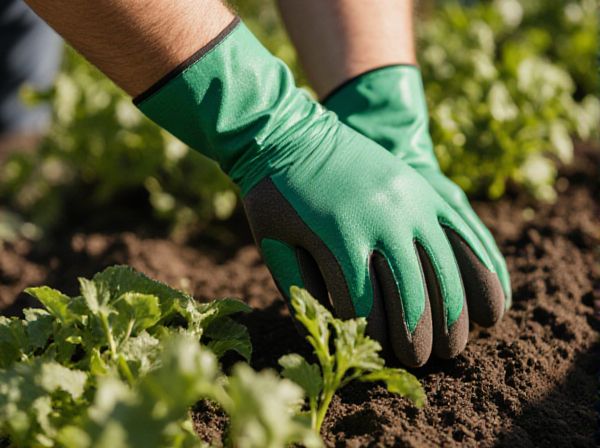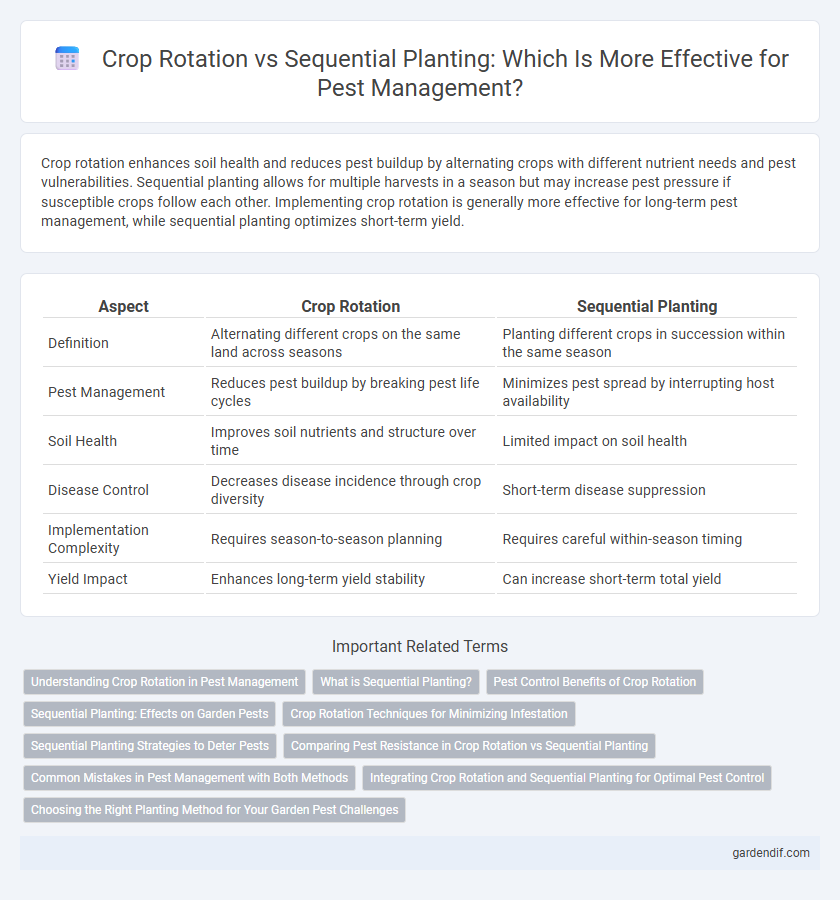
Crop rotation vs Sequential planting Illustration
Crop rotation enhances soil health and reduces pest buildup by alternating crops with different nutrient needs and pest vulnerabilities. Sequential planting allows for multiple harvests in a season but may increase pest pressure if susceptible crops follow each other. Implementing crop rotation is generally more effective for long-term pest management, while sequential planting optimizes short-term yield.
Table of Comparison
| Aspect | Crop Rotation | Sequential Planting |
|---|---|---|
| Definition | Alternating different crops on the same land across seasons | Planting different crops in succession within the same season |
| Pest Management | Reduces pest buildup by breaking pest life cycles | Minimizes pest spread by interrupting host availability |
| Soil Health | Improves soil nutrients and structure over time | Limited impact on soil health |
| Disease Control | Decreases disease incidence through crop diversity | Short-term disease suppression |
| Implementation Complexity | Requires season-to-season planning | Requires careful within-season timing |
| Yield Impact | Enhances long-term yield stability | Can increase short-term total yield |
Understanding Crop Rotation in Pest Management
Crop rotation disrupts pest life cycles by alternating crops with different pest affinities, reducing the buildup of pest populations in the soil. Sequential planting, while scheduling crops back-to-back, does not inherently break pest cycles and can sometimes increase pest pressure if vulnerable crops are planted consecutively. Implementing crop rotation with diverse plant families enhances pest management by creating unfavorable conditions for pests and promoting soil health.
What is Sequential Planting?
Sequential planting involves sowing crops in staggered intervals within the same growing season to optimize space, manage pest populations, and maximize yields. This method reduces the risk of pest infestations by disrupting pest life cycles and ensuring continuous ground cover. Sequential planting contrasts with crop rotation, which involves changing the type of crop grown each season to improve soil health and control pests over longer periods.
Pest Control Benefits of Crop Rotation
Crop rotation effectively disrupts pest life cycles by alternating host crops, reducing pest populations naturally and minimizing reliance on chemical pesticides. Diverse planting schedules in crop rotation enhance soil health and biodiversity, creating unfavorable conditions for pest establishment. Sequential planting, while beneficial for crop scheduling, lacks the pest management advantages intrinsic to rotating distinct crop families each season.
Sequential Planting: Effects on Garden Pests
Sequential planting disrupts pest life cycles by limiting the continuous availability of host plants, reducing pest populations naturally. Staggered planting dates create temporal gaps that inhibit pest reproduction and spread, promoting healthier crops without heavy pesticide use. This method enhances integrated pest management by encouraging beneficial predators and minimizing pest outbreaks in garden ecosystems.
Crop Rotation Techniques for Minimizing Infestation
Crop rotation techniques effectively reduce pest infestation by interrupting the life cycles of harmful insects and pathogens specific to certain crops. Implementing diverse crop sequences such as alternating legumes with cereals enhances soil health and creates unfavorable conditions for pest proliferation. Strategic rotation patterns, including the use of cover crops and non-host plants, limit pest population buildup and improve long-term crop resilience.
Sequential Planting Strategies to Deter Pests
Sequential planting strategies effectively disrupt pest life cycles by varying planting dates and crop types, reducing pest buildup and infestation risks. Alternating crops in a planned sequence minimizes host availability, limiting pest reproduction and spread while enhancing soil health. Integrating pest-resistant varieties and monitoring pest populations within sequential planting further strengthens pest deterrence in sustainable agriculture.
Comparing Pest Resistance in Crop Rotation vs Sequential Planting
Crop rotation enhances pest resistance by breaking pest life cycles through alternating crops with different pest susceptibilities, reducing pest populations over time. Sequential planting can sometimes lead to overlapping pest generations, increasing vulnerability to infestations due to continuous availability of host plants. Studies show that crop rotation more effectively minimizes pest damage compared to sequential planting by disrupting pest habitat and improving soil health.
Common Mistakes in Pest Management with Both Methods
Neglecting the specific pest life cycles when implementing crop rotation or sequential planting often leads to ineffective pest control, as pest populations may adapt or persist unnoticed. Overlooking the importance of timing and diversity in crop selection increases vulnerability to insect infestations and soil-borne diseases. Failure to monitor pest thresholds and integrate complementary pest management techniques further reduces the efficacy of both crop rotation and sequential planting strategies.
Integrating Crop Rotation and Sequential Planting for Optimal Pest Control
Integrating crop rotation with sequential planting enhances pest control by disrupting pest life cycles and reducing host plant availability. Crop rotation limits pest buildup by alternating plant families, while sequential planting staggers crop development stages to minimize pest colonization. Together, these strategies optimize pest suppression and promote sustainable agricultural practices.
Choosing the Right Planting Method for Your Garden Pest Challenges
Crop rotation disrupts pest life cycles by regularly changing plant families in the same area, reducing pest populations adapted to specific crops. Sequential planting involves staggering planting times to avoid peak pest infestations, minimizing damage by limiting pest food sources. Selecting the right method depends on the pest species, crop type, and garden size to effectively manage pest pressure and maintain soil health.
Crop rotation vs Sequential planting Infographic

 gardendif.com
gardendif.com